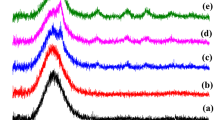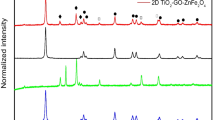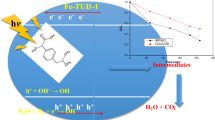Abstract
In this work, modification of TiO2 was carried out by incorporation of two novel Ru(II) polyaza complexes. The N1-(2-aminobenzyliden)-N2,N2-bis(2-(2-aminobenzyliden)aminoethyl)ethane-1,2-diaminoruthenium(II) and N1,N2-bis(2-aminobenziliden)ethane-1,2-diaminoruthenium(II) complexes were synthesized via metal–ligand direct reaction. The complexes were characterized by UV-Vis, FTIR and fluorescence spectroscopy, and the chemical composition was obtained from elemental analysis by the combustion method; additionally, the sensitized TiO2 catalysts were also characterized by XRD, SEM and diffuse reflectance techniques. The photocatalytic activity of the prepared catalysts was tested in a batch reactor under visible radiation for the degradation of ibuprofen in aqueous solution. The evolution of the drug degradation process was evaluated by high-performance liquid chromatography (HPLC), while the mineralization percentage was monitored by the determination of total organic carbon (TOC). The results indicated that the incorporation of these complexes improves the activation of TiO2 under visible light, increasing the degradation and mineralization percentage of ibuprofen up to 35% compared to the unmodified material, thereby making it suitable for application in heterogeneous photocatalysis of the said pharmaceutical in aqueous media using visible light as the energy source.
Similar content being viewed by others
References
N. De la Cruz, R. F. Dantas, J. Giménez and S. Esplugas, Photolysis and TiO2 photocatalysis of the pharmaceutical propranolol: Solar and artificial light, Appl. Catal., B, 2013, 130-131, 249–256.
A. L. Giraldo, et al. Degradation of the antibiotic oxolinic acid by photocatalysis with TiO2 in suspension, Water Res., 2010, 12, 5158–5167.
F. Méndez-Arriaga, S. Esplugas and J. Giménez, Photocatalytic degradation of non-steroidal anti-inflammatory drugs with TiO2 and simulated solar irradiation, Water Res., 2008, 12, 585–594.
D. Li, H. Haneda, S. Hishita and N. Ohashi, Visible-light-driven nitrogen-doped TiO2 photocatalysts: Effect of nitrogen precursors on their photocatalysis for decomposition of gas-phase organic pollutants, Mater. Sci. Eng., B, 2005, 12, 67–75.
E. S. Elmolla and M. Chaudhuri, Photocatalytic degradation of amoxicillin, ampicillin and cloxacillin antibiotics in aqueous solution using UV/TiO2 and UV/H2O2/TiO2 photocatalysis, Desalination, 2010, 12, 46–52.
S. Nakade, et al. lnfluence of TiO2 Nanoparticle Size on Electron Diffusion and Recombination in Dye-Sensitized TiO2 Solar Cells, J. Phys. Chem. B, 2003, 12, 8607–8611.
A. Fujishima, X. Zhang and D. A. Tryk, TiO2 photocatalysis and related surface phenomena, Surf. Sci. Rep., 2008, 12, 515–582.
C. Belver, R. Bellod, A. Fuerte and M. Fernandez-Garcia, Nitrogen-containing TiO2 photocatalysts. Part 1. Synthesis and solid characterization, Appl. Catal., B, 2006, 65, 301–308.
H. Park, Y. Park, W. Kim and W. Choi, Surface modification of TiO2 photocatalyst for environmental applications, J. Photochem. Photobiol., C, 2013, 12, 1–20.
M. A. Henderson, A surface science perspective on TiO2 photocatalysis, Surf. Sci. Rep., 2011, 12, 185–297.
C. Di Valentin, et al. N-doped TiO2: Theory and experiment, Chem. Phys., 2007, 12, 44–56.
P. Kar, et al. Sensitization of nanocrystalline TiO2 anchored with pendant catechol functionality using a new tetracyanato ruthenium(II) polypyridyl complex, lnorg. Chem., 2010, 49, 4167–4174.
J. Warnan, et al. Ruthenium sensitizer functionalized by acetylacetone anchoring groups for dye-sensitized solar cells, J. Phys. Chem. C, 2013, 12, 8652–8660.
N. Onozawa-Komatsuzaki, et al. Near-IR sensitization of nanocrystalline TiO2 with a new ruthenium complex having a 2, 6-bis(4-carboxyquinolin-2-yI)pyridine ligand, lnorg. Chem. Commun., 2009, 12, 1212–1215.
T. Funaki, et al. Ruthenium (II) complexes with expanded Iigand having phenylene-ethynylene moiety as sensitizers for dye-sensitized solar cells, Sol. Energy Mater. Sol. Cells, 2009, 12, 729–732.
S. Fan, C. Kim, B. Fang and K. Liao, lmproved efficiency of over 10% in dye-sensitized solar cells with a ruthenium complex and an organic dye heterogeneously positioning on a single TiO2 electrode, J. Phys. Chem. C, 2011, 7747–7754.
W. Kaim, Concepts for metal complex chromophores absorbing in the near infrared, Coord. Chem. Rev., 2011, 12, 2503–2513.
P. Giokas and S. Miller, Spectroscopy and Dynamics of Phosphonate-Derivatized Ruthenium Complexes on TiO2, J. Phys. Chem. C, 2013, 12, 812–824.
L. Feng, E. D. Van Hullebusch, M. A. Rodrigo, G. Esposito and M. A. Oturan, Removal of residual anti-inflammatory and analgesic pharmaceuticals from aqueous systems by electrochemical advanced oxidation processes. A review, Chem. Eng. J., 2013, 12, 944–964.
J. Kim, H. Jang and J. Kim, Occurrence of pharmaceutical and personal care products (PPCPs) in surface water from Mankyung River, South Korea, J. Health Sci., 2009, 12, 249–258.
R. Reif, S. Suarez, F. Omil and J. M. Lema, Fate of pharmaceuticals and cosmetic ingredients during the operation of a MBR treating sewage, Desalination, 2008, 12, 511–517.
S. Ortiz de Garcia, G. Pinto Pinto, P. Garcia Encina and R. Irusta Mata, Consumption and occurrence of pharmaceutical and personal care products in the aquatic environment in Spain, Sci. Total Environ., 2013, 12, 451–465.
W.-J. Sim, et al. Occurrence and distribution of pharmaceuticals in wastewater from households, livestock farms, hospitals and pharmaceutical manufactures, Chemosphere, 2011, 82, 179–186.
J. Rivera-Utrilla, M. Sanchez-Polo, M. A. Ferro-Garcia, G. Prados-Joya and R. Ocampo-Pérez, Pharmaceuticals as emerging contaminants and their removal from water. A review, Chemosphere, 2013, 12, 1268–1287.
J. B. EIIis, Pharmaceutical and personal care products (PPCPs) in urban receiving waters, Environ. Pollut., 2006, 12, 184–189.
O. A. Jones, J. N. Lester and N. Voulvoulis, Pharmaceuticals: A threat to drinking water?, Trends Biotechnol., 2005, 12, 163–167.
T. E. FéIix-Canedo, J. C. Duran-Alvarez and B. Jiménez-Cisneros, The occurrence and distribution of a group of organic micropollutants in Mexico City’s water sources, Sci. Total Environ., 2013, 454-455, 109–118.
J.-L. Liu and M.-H. Wong, Pharmaceuticals and personal care products (PPCPs): a review on environmental contamination in China, Environ. Int., 2013, 12, 208–224.
J. F. Gongora-Gomez, et al. Sensitization of TiO2 with novel Cu(II) and Ni(II) polyaza complexes: Evaluation of its photocatalytic activity, Ceram. Int., 2014, 12, 14207–14214.
X.-H. Wei, et al. Two sensitizers of Tb(III) constructed from alkaline earth metals and semi-rigid tripodal Iigand, lnorg. Chim. Acta, 2014, 12, 207–214.
T. Suresh, et al. Novel ruthenium sensitizer with multiple butadiene equivalent thienyls as conjugation on ancillary Iigand for dye-sensitized solar cells, Org. Electron., 2013, 12, 2243–2248.
N. Bahadur, K. Jain, R. Pasricha, Govind and S. Chand, Selective gas sensing response from different Ioading of Ag in soI-gel mesoporous titania powders, Sens. Actuators, B, 2011, 12, 112–120.
M. A. Behnajady and H. Eskandarloo, Silver and copper coimpregnated onto TiO2-P25 nanoparticles and its photocatalytic activity, Chem. Eng.J., 2013, 12, 1207–1213.
A. Kruth, A. Quade, V. Brüser and K. Weltmann, PIasma-Enhanced Synthesis of Poly (allylamine)-Encapsulated Ruthenium Dye-Sensitized Titania Photocatalysts, J. Phys. Chem. C, 2013, 12, 3804–3811.
C. Martinez, L. M. Canle, M. I. Fernandez, J. A. Santaballa and J. Faria, Aqueous degradation of diclofenac by heterogeneous photocatalysis using nanostructured materials, Appl. Catal., B, 2011, 12, 110–118.
T. Morikawa, R. Asahi, T. Ohwaki, K. Aoki and Y. Taga, Band-gap narrowing of titanium dioxide by nitrogen doping, Jpn. J. Appl. Phys., Part 2, 2001, 40, L561–L563.
A. V. Emeline, V. N. Kuznetsov, V. K. Rybchuk and N. Serpone, Visible-Light-Active Titania Photocatalysts: The Case of N-Doped TiO2—Properties and Some Fundamental Issues, lnt. J. Photoenergy, 2008, 12, 1–19.
D. G. Brown, P. A. Schauer, J. Borau-Garcia, B. R. Fancy and C. P. Berlinguette, Stabilization of ruthenium sensitizers to TiO2 surfaces through cooperative anchoring groups, J. Am. Chem. Soc., 2013, 12, 1692–1695.
S. Banerjee, et al. New Insights into the Mechanism of Visible Light Photocatalysis, J. Phys. Chem. Lett., 2014, 12, 2543–2554.
K. Suttiponparnit, et al. Role of Surface Area, Primary Particle Size, and Crystal Phase on Titanium Dioxide Nanoparticle Dispersion Properties, Nanoscale Res. Lett., 2011, 12, 1–8.
Y. Fu and W. Cao, The effect of potential on the electrontrapping process of surface states in nanocrystalline TiO2 film electrode, J. Appl. Phys., 2006, 12, 084324.
M. Buchalska, et al. On Oxygen Activation at Rutile- and Anatase-TiO2, ACS Catal., 2015, 12, 7424–7431.
A. Imanishi, T. Okamura, N. Ohashi, R. Nakamura and Y. Nakato, Mechanism of water photooxidation reaction at atomically flat TiO2 (rutile) (110) and (100) surfaces: Dependence on solution pH, J. Am. Chem. Soc., 2007, 12, 11569–11578.
A. Tsujiko, et al. Observation of cathodic photocurrents at nanocrystalline TiO2 film electrodes, caused by enhanced oxygen reduction in alkaline solutions, J. Phys. Chem. B, 2002, 12, 5878–5885.
T. Loftsson and M. E. Brewster, Pharmaceutical applications of cyclodextrins: Drug solubilisation and stabilization, J. Pharm. Sci., 1996, 12, 1017–1025.
I. Vergili, Application of nanofiltration for the removal of carbamazepine, diclofenac and ibuprofen from drinking water sources, J. Environ. Manage., 2013, 12, 177–187.
F. Méndez-Arriaga, M. I. Maldonado, J. Gimenez, S. Esplugas and S. Malato, Abatement of ibuprofen by solar photocatalysis process: Enhancement and scale up, Catal. Today, 2009, 12, 112–116.
R. Baccar, M. Sarr, J. Bouzid, M. Feki and P. Blanquez, Removal of pharmaceutical compounds by activated carbon prepared from agricultural by-product, Chem. Eng. J., 2012, 211-212, 310–317.
E. Illés, et al. Hydroxyl radical induced degradation of ibuprofen, Sci. Total Environ., 2013, 12, 286–292.
D. Dimitrakopoulou, et al. Degradation, mineralization and antibiotic inactivation of amoxicillin by UV-A/TiO2 photocatalysis, J. Environ. Manage., 2012, 12, 168–174.
Z. Khuzwayo and E. M. N. Chirwa, Modelling and simulation of photocatalytic oxidation mechanism of chlorohalogenated substituted phenols in batch systems: Langmuir-Hinshelwood approach, J. Hazard. Mater., 2015, 12, 459–466.
D. WANG, Experimental Conditions for Valid Langmuir-Hinshelwood Kinetics, Chin. J. Catal., 2010, 31, 972–978.
M. L. Maya-Trevino, M. Villanueva-Rodriguez, J. L. Guzman-Mar, L. Hinojosa-Reyes and A. Hernandez-Ramirez, Comparison of the solar photocatalytic activity of ZnO-Fe2O3 and ZnO-Fe(0) on 2, 4-D degradation in a CPC reactor, Photochem. Photobiol. Sci., 2015, 14, 543–549.
F. Méndez-Arriaga, S. Esplugas and J. Giménez, Degradation of the emerging contaminant ibuprofen in water by photo-Fenton, Water Res.., 2010, 44, 589–595.
S. Malato, P. Fernandez-Ibanez, M. I. Maldonado, J. Blanco and W. Gernjak, Decontamination and disinfection of water by solar photocatalysis: Recent overview and trends, Catal. Today, 2009, 12, 1–59.
Author information
Authors and Affiliations
Corresponding author
Additional information
Electronic supplementary information (ESI) available. See DOI: 10.1039/c6pp00222f
Rights and permissions
About this article
Cite this article
Góngora, J.F., Elizondo, P. & Hernández-Ramírez, A. Photocatalytic degradation of ibuprofen using TiO2 sensitized by Ru(II) polyaza complexes. Photochem Photobiol Sci 16, 31–37 (2017). https://doi.org/10.1039/c6pp00222f
Received:
Accepted:
Published:
Issue Date:
DOI: https://doi.org/10.1039/c6pp00222f




